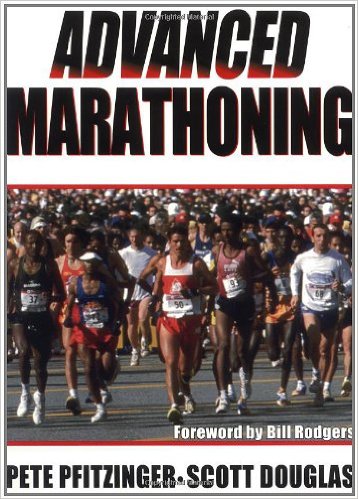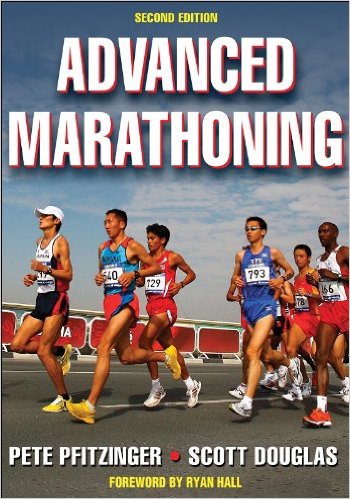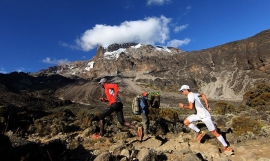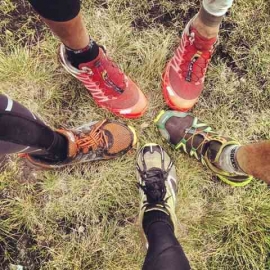《Advanced Marathoning》(2008年版)下载地址:
Advanced Marathoning(第二版)_Pete Pfitzinger;Scott Douglas_2008.pdf
//www.nduoke.com/shujixiazai/0736074600-advanced-marathoning-download
Pete Pfitzinger 出版的书籍:
Advanced Marathoning_Pete Pfitzinger;Scott Douglas_2001|2008
//www.nduoke.com/shujibaike/shuji-0653
Faster Road Racing: 5K to Half Marathon_Pete Pfitzinger;Philip Latter_2014
//www.nduoke.com/shujibaike/shuji-0654
Road Racing for Serious Runners: Multispeed Training- 5K to Marathon_Pete Pfitzinger;Scott Douglas_1998
//www.nduoke.com/shujibaike/shuji-0655
《Advanced Marathoning》简介:
Want to run a faster marathon? Commitment and hard work are essential but you also need to train smarter to run faster. Advanced Marathoning contains all the information you'll need to run faster, peak for multiple marathons without injury, and meet your marathon goal—whether it's running a personal best, qualifying for the Boston Marathon or winning your age division.
Shave minutes off your time using the latest in science-based training for serious runners. Advanced Marathoning has all the information you need to train smarter, remain injury free, and arrive on the start line ready to run the marathon of your life.
Including marathon-pace runs and tempo runs, Advanced Marathoning provides only the most effective methods of training. You'll learn how to complement your running workouts with strength, core, flexibility, and form training; implement cutting-edge nutrition and hydration strategies and recovery techniques; and taper properly to reach peak performance.
With easy-to-understand day-by-day training schedules for 18- and 12-week preparation for weekly distances of 55, 55 to 70, 70 to 85, and 85-plus miles, Advanced Marathoning is simply the most comprehensive and efficient approach to marathoning. If you're ready to achieve your personal best, this book is for you.
《Advanced Marathoning》目录:
Copyright Page
Dedication
Foreword
Preface
Acknowledgements
PART I - Training Components
Chapter 1 - Elements of Training
Marathon Physiology
How to Train to Improve the Key Physiological Attributes
Structuring Your Training Program: Periodization
Tune-Up Races
Chapter 2 - Nutrition and Hydration
The Importance of Hydration
Hope You Like Carbohydrate
The Role of Protein for Marathoners
The Importance of Iron
Supplements and Other Ergogenic Aids
Marathon Race-Day Nutrition and Hydration
Chapter 3 - Balancing Training and Recovery
Recovery and Supercompensation
The Hard/Easy Principle
Recovery Days (or Easy Days)
Avoiding Overtraining
Techniques to Speed Recovery
Chapter 4 - Supplementary Training
Flexibility Training
Core Stability Training
Strength Training
Running Form Drills
Aerobic Cross-Training
Chapter 5 - Tapering for Peak Marathon Performance
Benefits of Tapering
How Long Should You Taper?
How Should You Reduce Your Training to Improve Racing Performance?
Tapering Your Other Training
Preserving Energy (and Sanity) Before the Marathon
Chapter 6 - Race-Day Strategy
www.paobuziliao.com
Warming Up
Your Pacing Strategy
Altering Your Strategy Midrace
The First Half
On to 20 Miles (32 km)
The Final 6 Miles and 385 Yards (10 km)
PART II - Training Programs
Chapter 7 - Following the Schedules
Long Runs
Medium-Long Runs
Marathon-Pace Runs
General Aerobic Runs
Lactate-Threshold Runs
Recovery Runs
Omax Intervals
Speed Training
Doing Doubles
A Word About “Hard” Days
What About Hill Workouts?
Tweaking the Schedules
Chapter 8 - Marathon Training on Up to 55 Miles (88 km) per Week
Before Starting the Schedules
Reading the Schedules
Following the Schedules
Racing Strategies
After the Marathon
Chapter 9 - Marathon Training on 55 to 70 Miles (88 to 113 km) per Week
Before Starting the Schedules
Reading the Schedules
Following the Schedules
Racing Strategies
After the Marathon
Chapter 10 - Marathon Training on 70 to 85 Miles (113 to 137 km) per Week
Before Starting the Schedules
Reading the Schedules
Following the Schedules
Doing Doubles
Racing Strategies
After the Marathon
Chapter 11 - Marathon Training on More Than 85 Miles (137 km) per Week
Before Starting the Schedules
Reading the Schedules
Following the Schedules
Doing Doubles
When 105 Miles per Week Just Isn’t Enough
Racing Strategies
After the Marathon
Chapter 12 - Multiple Marathoning
Why Multiple Marathoning?
Reading the Schedules
Following the Schedules
Multiple-Marathoning Priorities
12-Week Schedule
10-Week Schedule
8-Week Schedule
6-Week Schedule
4-Week Schedule
Racing Strategies
After the Marathon
Appendix A - Marathon Race-Pace Chart
Appendix B - Lactate-Threshold Workout Charts
Appendix C - Omax Workout Chart
Glossary
References and Recommended Reading
In
dex
About the Authors
《Advanced Marathoning》Review
"Advanced Marathoning will be an invaluable tool to any runner wishing to apply world-class training methods to their program, regardless of what level they're competing at." Alberto SalazarFormer marathon world record holderTwo-time U.S. Olympic team memberFormer American-record holder, 5,000- and 10,000-meter runsNike sports marketing consultant
Review
”Advanced Marathoning will be an invaluable tool to any runner wishing to apply world-class training methods to their program, regardless of what level they're competing at.”
Alberto Salazar
Former marathon world record holder
Two-time U.S. Olympic team member
Former American-record holder, 5,000- and 10,000-meter runs
Nike sports marketing consultant
From the Publisher
”Advanced Marathoning will be an invaluable tool to any runner wishing to apply world-class training methods to their program, regardless of what level they’re competing at.”
Alberto Salazar Former marathon world record holder Two-time U.S. Olympic team member Former American-record holder, 5,000- and 10,000-meter runs Nike sports marketing consultant
”This is a book that could be used by the novice or professional alike. Not only does it give a day by day schedule, but it explains why each session is done along with the benefits that can be expected.”
Scott Larson Member, US teams at World Cross Country Championships, World Half Marathon Championships, World Road Relay Championships, and World University Games
About the Author
Pete Pfitzinger, the top American finisher at the 1984 and 1988 Olympic Marathons, is a distance running coach and exercise physiologist. He established himself as one of the best marathoners in U.S. history by outkicking Alberto Salazar to win the 1984 U.S. Olympic Marathon Trials. That same year he received the DeCelle award for America's best distance runner and was named Runner of the Year by the Road Runners' Club of America. He is also a two-time winner of the San Francisco Marathon and he finished third in the 1987 New York City Marathon. As a coach, Pfitzinger has more than 20 years' experience, including working with distance runners at the University of Massachusetts, University of New Hampshire, and Mount Holyoke College.
In his current position as an exercise physiologist, Pfitzinger specializes in working with endurance athletes. He is a contributing editor for Running Times, which features his monthly column, “The Pfitzinger Lab Report.” His writing has also appeared in American Health, Runner's World, and New England Runner. A graduate of Cornell University and the University of Massachusetts with a master's in exercise science, Pfitzinger lives in Auckland, New Zealand. He is the general manager of the New Zealand Academy of Sport, where he provides sport science and sports medicine services to Olympic and national class athletes.
Scott Douglas is a former editor-in-chief of Running Times. He has published articles in Runner's World, The Washington Post, and Women Outside and has been a columnist for Running Times and Marathon and Beyond. He was also an editor of Running & FitNews, a publication of the American Running Association. Douglas has co-authored two books with Bill Rodgers: Bill Rodgers' Lifetime Running Plan and The Complete Idiot's Guide to Jogging and Running.
Douglas has been a competitive runner since 1979, setting personal bests of 30:48 in the 10K, 51:01 in the 10-mile, and 1:08:40 in the half-marathon. Running competitively for almost 20 years, he has kept in tune with runners who have to fit training and racing around the demands of a career. Douglas resides in Bethesda, Maryland.
《Advanced Marathoning》读者评论:
Advanced Marathoning (AM) by Olympian Pete Pfitzinger and former Running Times editor Scott Douglas is packed with high-value training advice that should benefit every serious runner. AM is not without its problems, but none are serious enough to detract from a work that is well written and philosophically sound.
From the beginning Pfitzinger and Douglas make clear the basis of their views: "Advanced marathoning has to be based on more than common sense and running folklore. Advanced Marathoning, therefore, is based on exercise science." This declaration puts Pfitzinger and Douglas in the camp of exercise physiology, and, quite obviously, separates them from mainstream running authors. It's also a mild reproof of the mainstream and their penchant for ignoring the rapidly expanding world of exercise science.
Squarely on the side of science, AM begins by listing lactate threshold (LT), maximal aerobic capacity (VO2max), running economy, glycogen storage, recovery time, and muscle fiber composition as the key physiological variables that govern performance. The authors' claim, quite correctly, that "lactate threshold (LT) is the most important physiological variable for endurance athletes." They go on to say that "Contrary to many runner' beliefs, high levels of lactate (lactic acid) in your muscles aren't what make you sore for several days after a hard effort." Indeed, lactate, once considered metabolic waste, is "...produced by your muscles and is used by your muscles, heart, liver, and kidneys." Since the marathon is run at a speed slightly below LT, marathoners have a vested interest in raising LT. AM tells us how: "The most effective way to improve lactate threshold is to run at your current lactate threshold pace or a few seconds per mile faster, either as one continuous run (tempo run) or as a long interval session at your lactate threshold pace...." It's here that I have to quibble. Tempo runs are good LT workouts, however, recent research (Rusko, Billat, Anderson, and others) indicates that intervals at 3-K to 10-K speed with fairly long recoveries are better. Tempo runs definitely have their place, but not to the exclusion of faster LT sessions.
As for the other key variables, maximal aerobic capacity (VO2max), not as important as LT and only a rough predictor of performance, is also worth some attention. Pfitzinger and Douglas are right on the money again when they report "The most effective running intensity to improve VO2max is 95% to 100% of VO2max." This speed is normally close to 5-K pace. They wisely recommend work intervals of two to six minutes with rest intervals of equal length or slightly less. This is the standard, scientifically sound VO2max workout. However, it's interesting that velocity at VO2max (vVO2max) is not mentioned as another critical training intensity. Daniels, widely quoted in AM, has much to say about vVO2max, yet AM is silent on the subject. If recent work by Billat is correct, vVO2max could be a training intensity equal in importance to LT. This omission could be due to the long lead-time (sometimes 18 months) in getting a book published. AM may have gone to press before Billat's research was available.
In addition to physiological variables, Pfitzinger and Douglas have plenty to say about shoes, tapering, fluid replacement, nutrition, pre-race activities, post-race recovery, heart rate, periodization and a bevy other topics. They also present three very reasonable training schedules based on low, medium, and high mileage. Their only serious error regards altitude training. AM tells us that "Other than by training at altitude...the hemoglobin concentration of your blood won't increase with training." It should be well understood by now that living at altitude, not training at altitude, confers the benefit--hence the live high/train low protocol. Scores of endurance athletes are training at or near sea level by day and sleeping in hypoxic tents at night. Rusko (1998) has even constructed an altitude house. (See Gamow, Snell, Stine, Poronnet, Rusko, and Levine.)
All things considered, AM is well written, fairly well researched, and aside from an obvious typo in the first sentence of the third paragraph on page 18, also well edited. AM's puny bibliography was slightly disappointing. One would expect several pages of references in a work of this size. Nevertheless, AM is a worthy treatise, unfettered by the "folklore" so popular with the commercial running establishment. I give it a solid four stars and recommend it to every serious marathoner.
The dynamic duo of Pete Pfitzinger, renowned exercise physiologist and two- time Olympian, and Scott Douglas, former editor of the Running Times, have teamed up to write the latest and greatest text about marathoning. Quite simply, this book is a must read; the authors have produced a theoretically sound, easy-to-read, and entertaining manual for anyone seeking to run (i.e. as opposed to "finish" or "run-walk") a sub-four hour marathon. Advanced Marathoning has a number of outstanding features:
Numerous easy-to-read, day-by-day, training plans. From peak mileage at 55 miles per week over 12 weeks to 93 miles per week over 24 weeks, nine different marathon schedules are laid out and explained with daily detail.
A Multiple Marathons training plan. For runners who wish to tackle more than the standard yearly spring and fall marathon plan, the book details methods for racing marathons as close as four weeks apart.
A sidebar in each chapter which profiles a world class marathoner. These tales from the trenches illustrate how some of the principles of marathon training are applied in real life.
Practical advice about how to balance high commitment marathon training with the rest of a "normal" life. Since not all of us can make a living winning prize money in road races, the authors present practical tips for incorporating high mileage training into the rest of your busy life.
An entertaining writing style. The best line of the book comes on page 205 where the authors warn about trying to run back-to-back marathons in less than 4 weeks:
Your main concern should be about recovery, recovery, and more recovery not only from your first marathon but also from the lobotomy that led you to come up with this plan. Despite its many strengths, the book has two minor drawbacks: Hill training is glossed over. Hills are an essential part of almost any marathon training program. The authors acknowledge this, but they aren't specific about where, when, and how hills can be incorporated into a training plan.
The core strength training and flexibility training sections are brief. Specific diagrams illustrating some of the exercises written about would have been very helpful. These drawbacks, however, pale in comparison to all of the "good stuff." To repeat, this book is a must read.
Having logged a few marathons under my belt, I found a lot of programs and books out there were focused on the largest crowd. Those either wanting to complete a marathon, or those running less than 50 miles per week. But what I really wanted was a book on 'racing' a marathon. Specifically - how do I get as fast as my genetics (and age) will allow? I wanted programs that would push me further (safely) and make me work towards a PR of a sub-3 hour marathon in the next couple years.
I stumbled upon this book because of the other reviews, and thought I would echo the high ratings of this book. I'm now halfway through a 22 week program I put together from this book. The programs are actually 12 or 18 weeks, but I used the recovery section and the guidance presented in the book to ramp-up my mileage a little between my last marathon and my next one.
The book and the included plans are not for the faint of heart. The 'easiest' plan maxes at 55 miles per week. I'm on the 55-70 mile plan and it's tough! There are 70-85 mile plans and even a section on 100+ mile weeks and multi-marathoning in shorter periods of time that are thought to be sane.
The first part of the book provides a great overview of the concepts and guidelines that forms the basis of the plans. I've read a lot of articles and books on running, but there were some great new lessons learned and understanding I got from the first part of this book.
The second part are the plans. Even though you'll latch onto the one that best serves your needs, I found it very educational to go through each of them and see how they differed in their construction. It's not just the same plan with different mileages per day. The workouts and weeks are structured differently too.
The plan has me right on that razor edge of fatigue almost all the time. I feel I can go into my workouts strong, but you can definitely feel a little residue from the previous days. And just when you feel like you need a recovery run or day off, it's right there.
Results wise, I'm getting faster. I always felt that if you want to run distance faster, then you have to practice running distance fast. And the book shows you how to do that without over-taxing your system and burning out. I've also realized the importance of running my recovery workouts easier so I'm ready for the next quality workout. It makes every day interesting to have a theme or point to the workout - but I still enjoy the runs too - and that's kind of what it's about!





